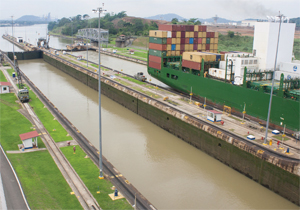Efforts to conserve fresh water at the Panama Canal could cost the global shipping industry up to $370 million per year and will likely cause year-over-year freight rates on Gulf of Mexico routes to rise markedly.
The Panama Canal Authority (PCA) imposed a $10,000 freshwater surcharge for all vessels over 125 feet in length beginning Feb. 15. The PCA cited rising temperatures that have resulted in historically low water levels in Gatun Lake, which supplies the canal’s locks. According to a prepared statement the canal authority provided to Professional Mariner, the measures will ensure transit reliability while a long-term solution is implemented.
Vessels will assume a variable fee between 1 percent and 10 percent of their toll, depending on the level of Gatun Lake during transit. If the lake has a higher level, the percentage will be lower and vice versa. Toll rates for ships longer than 100 feet increased from $3,200 to $4,100 starting Jan. 1.
The Panama Canal’s new measures also include a reduction in daily reservation slots from 32 to 27. Vessels that book in advance are guaranteed transit for a given date, and the canal may provide additional slots on a first-come, first-served basis, according to the PCA.
The International Chamber of Shipping criticized the freshwater surcharge as global demand weakened due to the coronavirus and higher operating costs following the Jan. 1 implementation of the 0.5 percent sulfur cap on fuel.
Kathy Metcalf, president of the Chamber of Shipping of America, told Professional Mariner that CSA members only use the canal occasionally. But she said new issues, such as this one, “should not be financially covered by a surcharge, but rather should be included in the budget and toll rates.”
Members of the World Shipping Council (WSC), which represents the global container fleet, were awaiting more information on long-term engineering solutions.
“Operators are hopeful that, to the greatest extent possible, those individual costs can be paid by the revenues of the canal as they stand now,” said John Butler, WSC president and chief executive officer.
The Panama Canal is expanding its investment program to find water supply solutions and is evaluating several options, including a pipeline to draw water from a lake at a higher elevation about 100 miles from the canal, the PCA told Professional Mariner. A dam to regulate water flow is also being considered.
Faced with higher costs, operators have passed some of the burden of canal transit on to customers. Maersk and the Mediterranean Shipping Co. have instituted Panama Canal surcharges of $30 per container.
For medium-range tankers arriving on the Atlantic side, the typical wait time for a pre-booked slot is eight to 10 days, compared with a maximum of five days before the Feb. 15 changes took effect, according to Marieke Alsguth, a senior pricing specialist for S&P Global Platts.
According to S&P’s year-over-year data for March, freight rates for medium-range tankers transporting clean petroleum products from the Gulf Coast to Chile increased by 44 percent. But Alsguth said the increase in bunker fuel prices following the Jan. 1 sulfur cap could have contributed to the increase.
“A lot of pricing is being affected by the reduced number of slots available per day,” she added.
According to the PCA, use of the reservation system has increased notably, and there have been longer waits for ships without reservations since Feb. 15. For help predicting the freshwater surcharge, operators can access a 60-day water level forecast on the PCA website.
With the freshwater surcharge and accompanying changes in place until further notice, Butler said the PCA has been open about its search for an engineering solution and will come back to users when it has answers. When that will happen, he added, remains uncertain.

